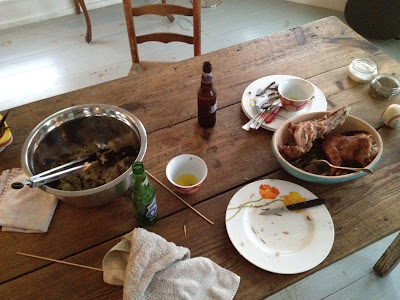Repeat, this post will include pictures through the full process of harvesting rabbits, cooking, and eating them. Not for the squeamish.
We bought 4 rabbits last fall, 3 girls and 1 boy. They procreated. We harvested 8 a while back, and thought we had the population under control. Turns out we started with TWO boys, something that clicked when the second round of babies appeared, unplanned.
On Sunday the kids and I did another round of rabbit harvesting.

Before getting into the rabbit raising business, I read several books on the subject. Pound for pound rabbit is one of the most efficient meat sources out there for environmental impact, meat to grain return, etc. I still wasn't sure I wanted to kill them. I saw a minute long youtube video of an old french farmer, picking up a rabbit, karate chopping it on the back of the neck, and taking it in to his kitchen. I tried this, and it worked very well. A quick chop, hang then up, and remove the head with a single stroke from a sharp butcher knife, starting behind the ears.

Note the mobile butcher station. Very simple, a comfortable working height, easily hosed down. Skinning is very simple on a young rabbit, (4 month old is the youngest we harvest,) a bit more work on an older rabbit. The principle is the same, cut around each back ankle, and from the ankle to the tail. The skin can then be pulled down, inside out, over the full body of the rabbit, and with a sharp tug, it will come free of the two front feet. Even with a young rabbit, it takes a little leverage: if the rabbit is tied firmly by it's foot that may suffice, but it may come free. (I wrap the ankle in wire and twist-fasten the wire to the cross rope. Puncturing the foot, as I've seen others do, is more likely to pull through during the skinning process.) For an older/tougher rabbit, you may need to grip the midsection for additional leverage. This can cause feces/urine to come out of the rabbit and get on the meat, which should be avoided. You can mitigate this by starting the cleaning process with an incision starting below the tail, down to however far you have worked the fur, and removing the bladder.
The rest of the gutting process is simply continuing the cut from tail to neck, and the majority of the organs will fall out. The diaphram will need to be punctured to remove the lungs and heart, this can be done with your fingers or a knife. Feet are removed by cutting the tendons around the last leg joint and twisting off. Or, a pair of meat-sheers can be used to snip the ankle bones. Just make sure you remove any bone-shards this might produce.

Completed rabbit, waiting to be rinsed in a steel bowl. With this setup, I recommend completing the full process up to this point with each rabbit, rather than completing one step on all rabbits being harvested before moving on to the next step. Getting each rabbit to this point is simply an easier process to manage.

Pelts go into a bucket of cold water. I'm going to give tanning these a try at some point, right now I'm simply tossing them in ziplocks and freezing them until I have time to experiment. My kids are very comfortable with the concept of where their food comes from, by the by.

This was the first time I decided to cook a rabbit whole. I have been butchering them down to hind legs kept whole, all other meat stripped, herbed, and ground into sausage. This 4 month old was brined in a saltwater solution overnight in the fridge.

Then rubbed down with more salt, and fresh rosemary.

Coals hot on the right, rabbit set on the left, lid closed, and cooked at 350 to 400 for about an hour.
Turned and basted with butter every 10 minutes or so.

At the same time, fresh green beans, potato, butter, and rabbit sausage set in an aluminum foil package, and set directly over the hot coals. (Started about 40 minutes after the rabbit.)



No comments:
Post a Comment